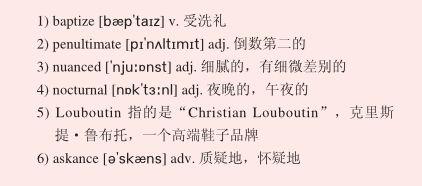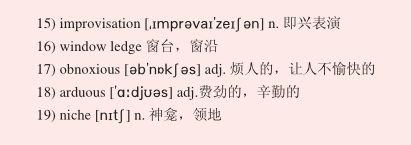索菲娅·科波拉:名门才女的“迷失与寻获”
2013-08-20byCarrieRickey
by Carrie Rickey
就像“肯尼迪”这个在美国政治圈影响力非凡的姓氏,冠上“科波拉”的名号在电影圈行走,别人会不自觉地对你肃然起敬。索菲娅·科波拉是好莱坞“任人唯亲”的受益者。索菲娅早年在父亲的电影中皆有出场表演机会,那些让多少人争得头破血流的机会,她唾手可得。她不缺乏机会、贵人、名利和奉承,但她需要真正意义上的认可和赞美。所以,她努力过,尝试过,摔倒过,思考过,终于,在导演这条路上,她找到了自己一直需要的如鱼得水和刮目相看。她的导演风格与父亲的恢弘大气完全不同,她喜欢小情调、小地方,她热衷于用女性的细腻捕捉那些生活中的曲调和故事,直戳观众的心窝。
“二代”并非中国特色,那种光环和优越感是令所有人艳羡不已的,当然,个中也有酸涩和苦恼,但这些往往为大众所忽略。如同那些有出息不糜烂的“二代”一样,索菲娅·科波拉努力在做的正是不玷污“科波拉”这块“金字招牌”,不辜负“科波拉”家族对每一个家庭成员的期许,兢兢业业,力争向父辈看齐。一个家族的强盛和繁衍要求这样的“二代”、“三代”从小就拥有家族自豪感和使命感,唯有热爱自己的家族与事业,他们才能维护和超越前人树立的丰碑。
——Mac
Some show business folk claim to be born in a trunk. Sofia Coppola was 1)baptized on a movie set: she is the infant christened in the 2)penultimate sequence of The Godfather (1972), directed by her father Francis Ford Coppola. Over the past 14 years, she has delivered two daughters of her own, as well as five feature films that have won acclaim; including a DGA and Oscar nomination for directing Lost in Translation; for her 3)nuanced portraits of teenagers and young adults losing and finding themselves.
Coppolas academic training is in photography. It took roughly a decade for her to evolve organically from still pictures to moving ones. Her latest film, The Bling Ring, follows the 4)nocturnal adventures of starstruck L.A. teens that steal into the homes, and closets, of celebs such as Paris Hilton and Lindsay Lohan. Based on “The Suspects Wore 5)Louboutins,” an improbable-but-true tale published in Vanity Fair, it looks 6)askance at these fashion felons who walk, quite literally, in the (stolen) shoes of their style idols.
有些娱乐明星声称自己出身于演艺世家。索菲娅·科波拉就是在一个电影场景里面接受洗礼的:她就是那个在电影《教父》(1972年)的倒数第二幕中接受洗礼的婴孩,而执导这部电影的正是她的父亲弗朗西斯·福特·科波拉。在过去的十四年中,她生了两个女儿,导演了五部电影故事片,并且因其细腻地描绘了青少年和年轻人迷失与寻找自我的过程而赢得不少赞誉,其中包括美国导演工会和奥斯卡最佳导演提名(电影《迷失东京》)。
科波拉的正规训练是从摄影开始的。从静态摄影过渡到动态电影拍摄,她用了差不多十年时间。她最新的电影作品——《珠光宝气》,讲述的是洛杉矶一帮追星青少年的午夜冒险之旅——潜入帕丽斯·希尔顿和林赛·罗韩等一众名人家中,从衣橱里偷东西。该电影是以刊登在《名利场》上的一篇文章——《好莱坞盗窃案》为蓝本拍摄,这个故事看上去匪夷所思,但却真有其事。影片用质疑的眼光看待那些大街上衣着时尚的罪犯,他们脚上穿的鞋子其实就是从潮流偶像那里偷来的。
“I thought it was such an interesting story and the quotes from the real kids really made an impression,” Coppola says, reflecting on her reaction to the story. “I thought the story said so much about our culture today and how it can affect young people.”
Mastering the small canvas rather than the big screen was Coppolas original goal. As a teenager she set her sights on becoming an artist. In the 1990s, she enrolled at the California Institute of the Arts (CalArts). “I wanted to be a painter,” she recalls over tea at a West Village cafe near her Manhattan 7)digs.“They told me I wasnt.”When she transferred to the Art Center College of Design, her photography instructor, Paul Jasmin, was more encouraging. “He told me my point of view was worth exploring.”
8)In any event, by the time Coppola enrolled at the Art Center she had already earned a doctoral 9)equivalency. “I didnt realize it at the time,”reflects the filmmaker, 42, poised and watchful. When it comes to the language of film, Coppola says, she was home schooled.
“我当时觉得这个故事很有意思,而那些犯错孩子的自白给我留下了深刻的印象,”科波拉说道,回想起自己当时对这个故事的反应。“我觉得这个故事深入探讨了我们现今的文化,以及这种文化如何影响年青一代。”
在小小的帆布上大展身手,而不是大屏幕,这是科波拉最初的目标。早在青少年时期,她就立志成为一名艺术家。在上世纪九十年代,她在加利福尼亚艺术学院就读。“我当时想成为一名画家。”她在自己曼哈顿寓所附近的西村咖啡店喝着茶回忆自己的过往。“他们告诉我不行。”当她转学到设计艺术中心学院的时候,她的摄影指导老师保罗·杰斯明,却不泼她冷水。“他告诉我,我的观点值得挖掘。”
不管如何,在科波拉就读于艺术中心之前,她已经取得了一个相当于博士学位的资格。“我当时还没有意识到这点,”这位现年42岁的电影制作人回忆着过去,从容而谨慎。当说到电影语言,科波拉说,自己是自学成才的。
“Dad always included us,” she said, referring to herself and brother Roman, also a director. “We were always talking about and looking at film. I didnt even realize I was learning.” Although 10)oblivious to much of her cinematic home schooling while it was happening, Coppola now acknowledges how decisively it has influenced her choices in preproduction, on set, and in post.
“爸爸总是让我们参与其中,”她说道,“我们”指的是她自己和同为导演的哥哥罗曼。“我们以前总是聊电影和看电影。我都不知道自己当时就是在学习。”尽管对于自己当时的家庭式电影教学懵懂不知,科波拉现在却认识到这些家庭教育对自己影片的前期制作、现场以及后期都有着决定性影响。
Still, there are significant stylistic differences between father and daughter. Where the elder Coppola is attracted to larger-than-life characters, employing tracking shots for epic scope and sweep, the younger works on a more intimate scale. Her 11)mantra is “less formality.” From Coppolas preference for a handheld camera that gets into her subjects personal space to her 12)painstaking use of 13)ambient sounds to create a you-are-there experience, “its about getting close and closer to the character.”
To create her signature shot, shadowing a character from behind, she likes to use a handheld camera or a dolly shot. Whether her camera stalks Scarlett Johansson exploring a Buddhist temple in Kyoto in Lost in Translation (2003) or Kirsten Dunst entering Versailles in Marie Antoinette(2006) or Emma Watson, teenage celebrity stalker in The Bling Ring, Coppola gentles you into their drifts and their dreams.
Coppola says she casts less for looks than for 14)simpatico. “I feel like there has to be a connection, you have to find the same things funny. That way, youre on the same channel and youll be able to communicate more effectively.”
当然,父女之间还是有着明显的风格差异。老科波拉对传奇人物形象情有独钟,喜欢用长镜头打造恢宏影像,小科波拉则喜欢着眼细处。她的行事原则是“少一点形式主义”。从科波拉对手持摄像机的偏爱——这样可以进入人物的内心世界,到其小心谨慎采用环境声效来营造一种“你在现场”的体验,“这都是为了更加进一步接近人物的内心。”
为了打造她的标志性镜头,从背后追随角色,她喜欢采用手持摄像机或是移动式摄影车。无论是在2003年的《迷失东京》中她的镜头追随着斯嘉丽·约翰逊探索京都佛寺,还是在2006年《绝代艳后》中克尔斯顿·邓斯特进入凡尔赛宫,又或是艾玛·沃特森这个《珠光宝气》里面的追星族,科波拉都循循诱导你进入人物内心,感受她们的际遇以及梦想。
科波拉说自己选角看重的是志趣相投,而不是外貌形象。“我觉得要有一种共鸣感,必须对同样的事物感觉有趣。这样,你们能志同道合,可以更有效地沟通。”
From the start, all of Coppolas films have been image rather than dialogue intensive. “I dont want my movies to feel like movies,”she says. “I want them to feel like life.” If theres less smart talk than small talk in her films, its because she believes thats how life is. “People dont really express themselves that articulately in real life.” And to get more of that in the moment feel, she encourages 15)improvisation from her actors.
“Remember Scarlett perched in the 16)window ledge in Lost in Translation, looking out over Tokyo?” she asks. “You project your feelings on her. Thats what Im going for. I want the visual ways to tell the story rather than have the characters talk.”Whats unsaid speaks volumes.
From her father, Coppola learned that “a movie is never as bad as the first rough cut.”Still, the rough of The Virgin Suicides crushed her. Fortunately, she had sound designer Beggs on board as well as Reitzell, onetime drummer of Redd Kross. “You find the rhythm in the edit.” For her, the films pace is almost always guided by the movement inside the frame and by the tempo of the soundtrack, which in The Bling Ring is louder, and in Coppolas description, “more 17)obnoxious”than the dreamy music in most of her films.
从第一部电影开始,科波拉的所有电影就注重影像,而非对话。“我不想我的电影看上去像电影,”她说,“我希望电影看上去像生活。”如果说在她的电影中警言隽语少,闲言碎语也不多,那是因为她相信生活就应该是这样的。“在现实生活中人们其实不是那么能言善表。”为了得到更多那种“当下”的感觉,她鼓励自己的演员即兴表演。
“记得斯嘉丽在《迷失东京》中坐在窗台上,俯看整个东京那一幕吗?”她问。“你把自己的想法投射在她的身上。那就是我一直追求的。我希望用影像的方式来讲故事,而非通过人物对话。”此时无声胜有声。
从她父亲那里,科波拉了解到“一部电影在初剪后实在是惨不忍睹”。但是,《处女之死》的初剪片还是让她痛苦难堪。幸运的是,她身边有声音设计师贝格斯以及雷德·克洛斯的临时鼓手雷泽赛尔支持她。“你在剪接的过程中找到了节奏。”对她来说,一部电影的节奏几乎总是由电影里面的情节以及原声音乐的拍子来主导的,而这点在《珠光宝气》中更为明显,用科波拉自己的话说就是,比起她大部分电影里面的美妙原声,这显得“更讨嫌”。
Like her father, Coppola plays music on the set, frequently the same cuts she listened to while writing the screenplay. She thinks it helps establish mood. She favors actual locations over shooting studio sets because a location; Tokyo in Lost in Translation, Versailles in Marie Antoinette, Hollywood and Milan in Somewhere, Los Angeles in The Bling Ring; has an energy and authenticity that cant be replicated in a studio. “I like a small crew,” she says. “I like to keep it as lean and simple as possible.”
Coppola made The Bling Ring on a still-modest$20 million budget. Lost in Translation, her biggest hit to date, cost only $4 million to make (and grossed $120 million worldwide). Except for Marie Antoinette, which had a $40 million budget and an 18)arduous 12 week shoot mostly in France, Coppola prefers to keep things smaller and more intimate.
Having completed her fifth feature, Coppola says she feels at home in what she perceives as her 19)niche; character-driven films mapping the moves of people lost in transition. “I dont make the kind of movies that lend themselves to wide releases,” she concludes.
跟她父亲一样,科波拉会在拍摄场景中播放音乐,常常在同一幕中播放她在撰写剧本时听的音乐。她认为这样有助于建立情绪氛围。她喜爱实地取景多于摄影棚拍摄,因为外景拍摄场地——《迷失东京》里的东京,《绝代艳后》中的凡尔赛宫,《在某处》中的好莱坞和米兰,以及《珠光宝气》中的洛杉矶——拥有一种摄影棚里无法复制的活力和真实感。“我喜欢小型的工作组,”她说道。“我喜欢尽量精简。”
科波拉拍摄的《珠光宝气》依然是低成本制作,只用了两千万美元。《迷失东京》——到目前为止她最为成功的作品,只花了四百万美元,全球票房总收入却达到了1.2亿美元。除了《绝代艳后》这部电影预算四千万美元,耗时12周,主要在法国拍摄之外,科波拉更钟情于小制作,着眼于私密情感上。
完成了自己的第五部电影之后,科波拉说她感觉很自在,就好像游刃于她自称的“专属领地”之中。这些以人物为主导的电影记录着在生活转变过程中的迷失者的一举一动。“我不是拍什么主流大片的人。”她总结道。
